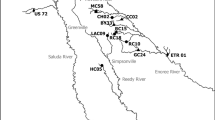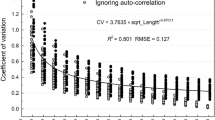Abstract
Most surveys of large wood in streams are conducted by counting and measuring every piece of large wood within a reach, a technique that is effective but time-consuming. In this study we evaluated an alternative method that takes less time and can be employed in studies in which an estimate of total large wood volume along a stream reach is the primary metric of interest. In first- through third-order streams we estimated in-stream large wood volume and large wood frequency, comparing large wood census estimates to those from a modified a line-intercept technique that has been commonly used in terrestrial forest surveys. Estimates of large wood volume from line transects located in the geographic center of the stream (parallel to stream axis and equidistant from bankfull margins) were highly correlated with those from the wood census (P < 0.001, r 2 = 0.88, Pearson’s r = 0.935), but produced slightly greater estimates of large wood volume (regression slope = 1.28, SE = 0.16). Line-intercept estimates of large wood frequency (number per 100 m of stream) were significantly correlated to the wood census counts, but the line-intercept method underestimated frequency by about 50% (P = 0.016). Differences in the estimated large wood volume between line-intercept and wood census surveys were associated with variability in the diameter of the large wood, but unrelated to stream bankfull width, for the range of stream sizes evaluated in this study (≈ 2 to 11 m). Our results suggest that in small constrained streams, line-intercept surveys are an effective method for estimating in-stream large wood volume and that these estimates better approximate results from whole-stream census techniques where the diameter of in-stream wood is relatively consistent.




Similar content being viewed by others
References
Baillie, B. R., T. L. Cummins & M. O. Kimberley, 1999. Measuring woody debris in the small streams of New Zealand’s pine plantations. New Zealand Journal of Marine and Freshwater Research 33: 87–97.
Bate, L. J., T. R. Torgersen, M. J. Wisdom & E. O. Garton, 2004. Performance of sampling methods to estimate log characteristics for wildlife. Forest Ecology and Management 199: 83–102.
Bilby, R. E., 1981. Role of organic debris dams in regulating the export of dissolved and particulate matter from a forested watershed. Ecology 62: 1234–1243.
Bisson, P. A., R. E. Bilby, M. D. Bryant, C. A. Dolloff, G. B. Grette, R. A. House, M. L. Murphy, K. V. Koski & J. R. Sedell, 1987. Large woody debris in forested streams in the Pacific Northwest: past, present, future. In Salo, E. O. & T. W. Cundy (eds), Streamside management: forestry and fishery interactions. University of Washington. Seattle, pp 143–190.
Chen, X. Y., X. H. Wei, R. Scherer, C. Luider & W. Darlington, 2006. A watershed scale assessment of in-stream large woody debris patterns in the southern interior of British Columbia. Forest Ecology and Management 229: 50–62.
Gippel, C. J., B. L. Finlayson & I. C. ONeill, 1996. Distribution and hydraulic significance of large woody debris in a lowland Australian river. Hydrobiologia 318: 179–194.
Gregory, S., K. Boyer, A. Gurnell (eds), 2003. The ecology and management of wood in world rivers. American Fisheries Society, Bethesda, MD, p 431.
Kaiser, L., 1983. Unbiased estimation in line-intercept sampling. Biometrics 39: 965–976.
Keeton, W. S., C. E. Kraft & D. R. Warren, 2007. Mature and old-growth riparian forests: structure, dynamics, and effects on Adirondack stream habitats. Ecological Applications 17: 852–868.
Keim, R. F., A. E. Skaugset & D. S. Bateman, 2000. Dynamics of coarse woody debris placed in three Oregon streams. Forest Science 46: 13–22.
Kraft, C. E. & D. R. Warren, 2003. Development of spatial pattern in large woody debris and debris dams in streams. Geomorphology 51: 127–139.
Latterell, J. J., J. S. Bechtold, T. C. O’Keefe, R. Van Pelt & R. J. Naiman, 2006. Dynamic patch mosaics and channel movement in an unconfined river valley of the Olympic Mountains. Freshwater Biology 51: 523–544.
Meleason, M. A., R. Davies-Colley, A. Wright-Stow, J. Horrox & K. Costley, 2005. Characteristics and geomorphic effect of wood in New Zealand’s native forest streams. International Review of Hydrobiology 90: 466–485.
MINITAB® Release 14.20. 2005. Minitab Inc. State College, PA.
Montgomery, D. R., J. M. Buffington, R. D. Smith, K. M. Schmidt & G. Pess, 1995. Pool spacing in forest channels. Water Resources Research 31: 1097–1105.
Nakamura, F. & F. J. Swanson, 1994. Distribution of coarse woody debris in a mountain stream, western cascade range, Oregon. Canadian Journal of Forest Research-Revue Canadienne De Recherche Forestiere 24: 2395–2403.
O’Connor, N. A., 1992. Quantification of submerged wood in a lowland Australian stream system. Freshwater Biology 27: 387–395.
Richmond, A. D. & K. D. Fausch, 1995. Characteristics and function of large woody debris in subalpine Rocky Mountain streams in northern Colorado. Canadian Journal of Fisheries and Aquatic Science 52: 1789–1802.
Roni, P. & T. P. Quinn, 2001. Density and size of juvenile salmonids in response to placement of large woody debris in western Oregon and Washington streams. Canadian Journal of Fisheries and Aquatic Science 58: 282–292.
Shivers, B. D. & B. E. Borders, 1996. Sampling techniques for forest inventory. John Wiley and Sons, New York, USA. p 356.
Thevenet, A. & B. Statzner, 1999. Linking fluvial fish community to physical habitat in lary wood debris: sampling effort, accuracy and precision. Archives of Hydrobiology 145: 57–77.
Valett, H. M., C. L. Crenshaw & P. F. Wagner, 2002. Stream nutrient uptake, forest succession, and biogeochemical theory. Ecology 83: 2888–2901.
VanWagner, C., 1968. Line intersect method in forest fuel sampling. Forest Science 14: 20–26.
Wallace, J. B. & A. C. Benke, 1984. Quantification of wood habitat in sub-tropical coastal-plain streams. Canadian Journal of Fisheries and Aquatic Sciences 41: 1643–1652.
Warren, W. G. & P. F. Olsen, 1964. A line intersect technique for assessing logging waste. Forest Science 13: 267–276.
Woldendorp, G., R. J. Keenan, S. Barry & R. D. Spencer, 2004. Analysis of sampling methods for coarse woody debris. Forest Ecology and Management 198: 133–148.
Young, M. K., E. A. Mace, E. T. Ziegler & E. K. Sutherland, 2006. Characterizing and contrasting instream and riparian coarse wood in western Montana basins. Forest Ecology and Management 226: 26–40.
Acknowledgements
We would like to thank field crews from both Cornell University and the University of Vermont for help in woody debris surveys. We thank Marissa Weiss and Bethany Boisvert for helpful comments on earlier drafts of this manuscript. Funding for this research was provided by the USDA Forest Service, McIntire-Stennis Forest Research Program; and the Cornell Biogeochemistry and Environmental Biocomplexity NSF IGERT grant (NSF DGE-0221658).
Author information
Authors and Affiliations
Corresponding author
Additional information
Handling editor: K. Martens
Rights and permissions
About this article
Cite this article
Warren, D.R., Keeton, W.S. & Kraft, C.E. A comparison of line-intercept and census techniques for assessing large wood volume in streams. Hydrobiologia 598, 123–130 (2008). https://doi.org/10.1007/s10750-007-9144-8
Received:
Revised:
Accepted:
Published:
Issue Date:
DOI: https://doi.org/10.1007/s10750-007-9144-8




